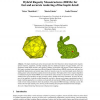Free Online Productivity Tools
i2Speak
i2Symbol
i2OCR
iTex2Img
iWeb2Print
iWeb2Shot
i2Type
iPdf2Split
iPdf2Merge
i2Bopomofo
i2Arabic
i2Style
i2Image
i2PDF
iLatex2Rtf
Sci2ools
CLEIEJ
2010
2010
Hybrid Rugosity Mesostructures (HRMs) for fast and accurate rendering of fine haptic detail
The haptic rendering of surface mesostructure (fine relief features) in dense triangle meshes requires special structures, equipment, and high sampling rates for detailed perception of rugged models. Low cost approaches render haptic texture at the expense of fidelity of perception. We propose a faster method for surface haptic rendering using image-based Hybrid Rugosity Mesostructures (HRMs), paired maps with per-face heightfield displacements and normal maps, which are layered on top of a much decimated mesh, effectively adding greater surface detail than actually present in the geometry. The haptic probe's force response algorithm is modulated using the blended HRM coat to render dense surface features at much lower costs. The proposed method solves typical problems at edge crossings, concave foldings and texture transitions. To prove the wellness of the approach, a usability testbed framework was built to measure and compare experimental results of haptic rendering approaches ...
CLEIEJ 2010 | Haptic Rendering | Haptic Rendering Approaches | Haptic Texture | Information Technology |
| Added | 01 Mar 2011 |
| Updated | 01 Mar 2011 |
| Type | Journal |
| Year | 2010 |
| Where | CLEIEJ |
| Authors | Víctor Theoktisto, Marta Fairén González, Isabel Navazo |
Comments (0)

